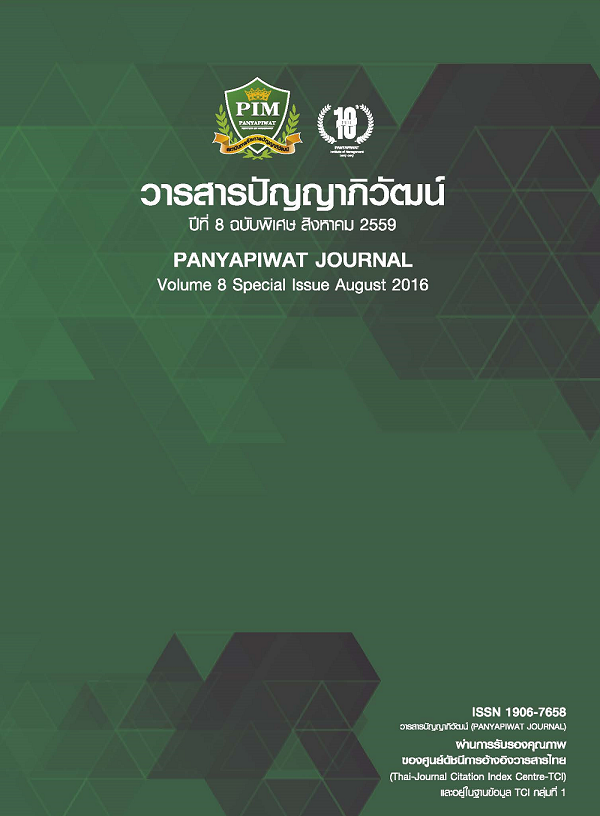ระบบแจ้งเตือนโซเชียลมีเดียไทยสำาหรับธุรกิจด้วยซัพพอร์ทเวกเตอร์แมชชีน
Main Article Content
บทคัดย่อ
ในปัจจุบันสื่อสังคมออนไลน์ได้รับความนิยมมากขึ้น เนื่องด้วยเป็นช่องทางที่รวดเร็วและเข้าถึงได้ง่าย ทำให้ผู้ใช้เข้ามาแสดงความคิดเห็น แลกเปลี่ยนประสบการณ์ต่างๆ รวมไปถึงธุรกิจที่ใช้ช่องทางสื่อสังคมออนไลน์ในการสื่อสารกับลูกค้าเช่นกัน หากกล่าวถึงสื่อสังคมออนไลน์ในประเทศไทยแล้ว เว็บบอร์ด Pantip ได้รับความนิยมมากในสังคมไทย ดังนั้นหากข้อมูลที่ปรากฏเป็นข้อมูลเชิงลบที่เกี่ยวข้องกับสินค้าหรือบริการอาจก่อให้เกิดความเสียหายกับธุรกิจได้ ดังนั้นเพื่อให้ธุรกิจจัดการข้อมูลบนสื่อสังคมออนไลน์ได้อย่างมีประสิทธิภาพ ธุรกิจควรจะต้องมีระบบแจ้งเตือนความคิดเห็นเชิงลบบนสื่อสังคมออนไลน์ เพื่อให้ธุรกิจสามารถจัดการกับปัญหาได้อย่างรวดเร็ว จะสามารถแก้ไขได้ทันท่วงที ในบทความวิจัยนี้จะเริ่มจากการสำรวจเครื่องมือสื่อสังคมออนไลน์ ตั้งแต่ปี 2548 จนถึงปัจจุบัน ซึ่งพบว่าแต่ละระบบมีข้อดีความแตกต่างกันไป แต่ทุกระบบยังไม่ตรงความต้องการของธุรกิจและพบว่ามีการจำแนกประเภทข้อมูลที่ผิดพลาดและไม่แจ้งเตือน ดังนั้นในงานวิจัยนี้จะนำเสนอระบบแจ้งเตือนธุรกิจบนสื่อสังคมออนไลน์บนพื้นฐานความต้องการของธุรกิจโดยใช้เทคนิคการเรียนรู้ของเครื่อง ระบบจะดึงข้อมูลจากเว็บบอร์ด Pantip ตามคำสำคัญ (Keywords) จากนั้นข้อมูลจะผ่านกระบวนการก่อนหน้า การสกัดคุณลักษณะโดย Term Frequency – Inverse Document Frequency (TF-IDF) และเข้าสู่ขั้นตอนการจำแนกประเภทด้วย Support Vector Machine (SVM) จากการทดลองพบว่าระบบมีประสิทธิภาพดีทั้งด้านความถูกต้องและด้านความไวและความจำเพาะ เมื่อเทียบกับผู้เชี่ยวชาญ
Nowadays, social media has exponential growth of information generated by social interactions. In this way, social media has a huge impact on how businesses connect with customers. Pantip.com is the one of the most popular webboard in Thailand in which the customers post their feedbacks about products and services. Among these feedbacks, some of them affect the business in a negative way. To solve this problem, businesses should have a system that can alert their customer’s negative feedbacks on social media. If the business can quickly deal with these negative feedbacks, the problems will be managed in timely fashion. Therefore, many businesses can take advantage of this market analysis information that can increase their opportunities in marketing. In this paper, the social media tools, that can utilized the data from social medias, are surveyed from 2005 to present. Each system provides different features, but none of them meet the business requirements, especially when the business cannot deal with the problem immediately because the negative sentiments are incorrectly classified and not alert. This paper proposes the social media alert system based on the business requirements. The machine learning technique is applied to determine which information should be alerted to business owners. The system monitors the data posted in Pantip.com that relates to the business by keywords. After the data were collected and preprocessed, feature vectors are extracted by Term Frequency-Inversed Document Frequency (TF-IDF) before feeding to Support Vector Machine (SVM). Experimental results show that it can achieved the good accuracy rate and also in terms of the sensitivity and specificity.
Article Details
“ข้าพเจ้าและผู้เขียนร่วม (ถ้ามี) ขอรับรองว่า บทความที่เสนอมานี้ยังไม่เคยได้รับการตีพิมพ์และไม่ได้อยู่ระหว่างกระบวนการพิจารณาลงตีพิมพ์ในวารสารหรือแหล่งเผยแพร่อื่นใด ข้าพเจ้าและผู้เขียนร่วมยอมรับหลักเกณฑ์การพิจารณาต้นฉบับ ทั้งยินยอมให้กองบรรณาธิการมีสิทธิ์พิจารณาและตรวจแก้ต้นฉบับได้ตามที่เห็นสมควร พร้อมนี้ขอมอบลิขสิทธิ์บทความที่ได้รับการตีพิมพ์ให้แก่สถาบันการจัดการปัญญาภิวัฒน์หากมีการฟ้องร้องเรื่องการละเมิดลิขสิทธิ์เกี่ยวกับภาพ กราฟ ข้อความส่วนใดส่วนหนึ่งและ/หรือข้อคิดเห็นที่ปรากฏในบทความข้าพเจ้าและผู้เขียนร่วมยินยอมรับผิดชอบแต่เพียงฝ่ายเดียว”
References
Akaichi, J., Dhouioui, Z., José, M. & Pérez, L.-H. (2013). Text Mining Facebook Status Updates for Sentiment Classification. Sinaia: System Theory, Control and Computing (ICSTCC), 2013 17th International Conference.
Binali, H., Wu, C. & Potdar, V. (2013). Computational Approaches for Emotion Detection in Text. In 4th IEEE International Conference on Digital Ecosystems and Technologies - Conference Proceedings of IEEE-DEST 2010, DEST 2010 (pp. 172-177). Digital Ecosystems and Technologies (DEST), 2010 4th IEEE International Conference on.
Brynielsson, J., Johansson, F., Jonsson, C. & Westling, A. (2014). Emotion classification of social media posts for estimating people’s reactions to communicated alert messages during crises. Security Informatics, 3(1), 7.
Facebook Reports First Quarter 2015 Results. (2015). Retrieved February 20, 2015, from http://investor.fb.com/releasedetail.cfm?ReleaseID=908022
Isah, H., Trundle, P. & Neagu, D. (2014). Social Media Analysis for Product Safety using Text Mining and Sentiment Analysis. Bradford: Computational Intelligence (UKCI), 2014 14th UK Workshop on, IEEE.
Naradhipa, A. R. & Purwarianti, A. (2011). Sentiment classification for Indonesian message in social media. In Proceedings of the 2011 International Conference on Electrical Engineering and Informatics (pp. 1-4). IEEE.
Pantip - Learn, Share & Fun. (n.d.). Retrieved December 20, 2015, from http://pantip.com/
Pantip.com Site Info. (n.d.). Alexa Internet. Retrieved February 17, 2015, from http://www.alexa.com/siteinfo/pantip.com
Phillips, S. (n.d.). A brief history of Facebook. The Guardian. Retrieved February 19, 2015, from http://www.theguardian.com/technology/2007/jul/25/media.newmedia
Sarakit, P., Theeramunkong, T., Haruechaiyasak, C. & Okumura, M. (2015). Classifying emotion in Thai youtube comments. In 2015 6th International Conference of Information and Communication Technology for Embedded Systems (IC-ICTES) (pp. 1-5). IEEE.
Satayamas, V. (2008). KUCut–Python. Retrieved February 20, 2015, from https://veer66.wordpress.com/2008/02/20/recent-postsuser-loginlog-in-using-openidwhat-is-openidusername-password-create-new-account-request-new-passwordlog-in-using-openidcancel-openid-login/
Scikit-learn. (2010). sklearn.svm.SVC — scikit-learn 0.17 documentation. Retrieved December 27, 2015, from http://scikit-learn.org/stable/modules/generated/sklearn.svm.SVC.html
Viriyavisuthisakul, S., Sanguansat, P., Charnkeitkong, P. & Haruechaiyasak, C. (2015). A comparison of similarity measures for online social media Thai text classification. In 2015 12th Inter-national Conference on Electrical Engineering/Electronics, Computer, Telecommunications and Information Technology (ECTI-CON) (pp. 1-6). IEEE.

